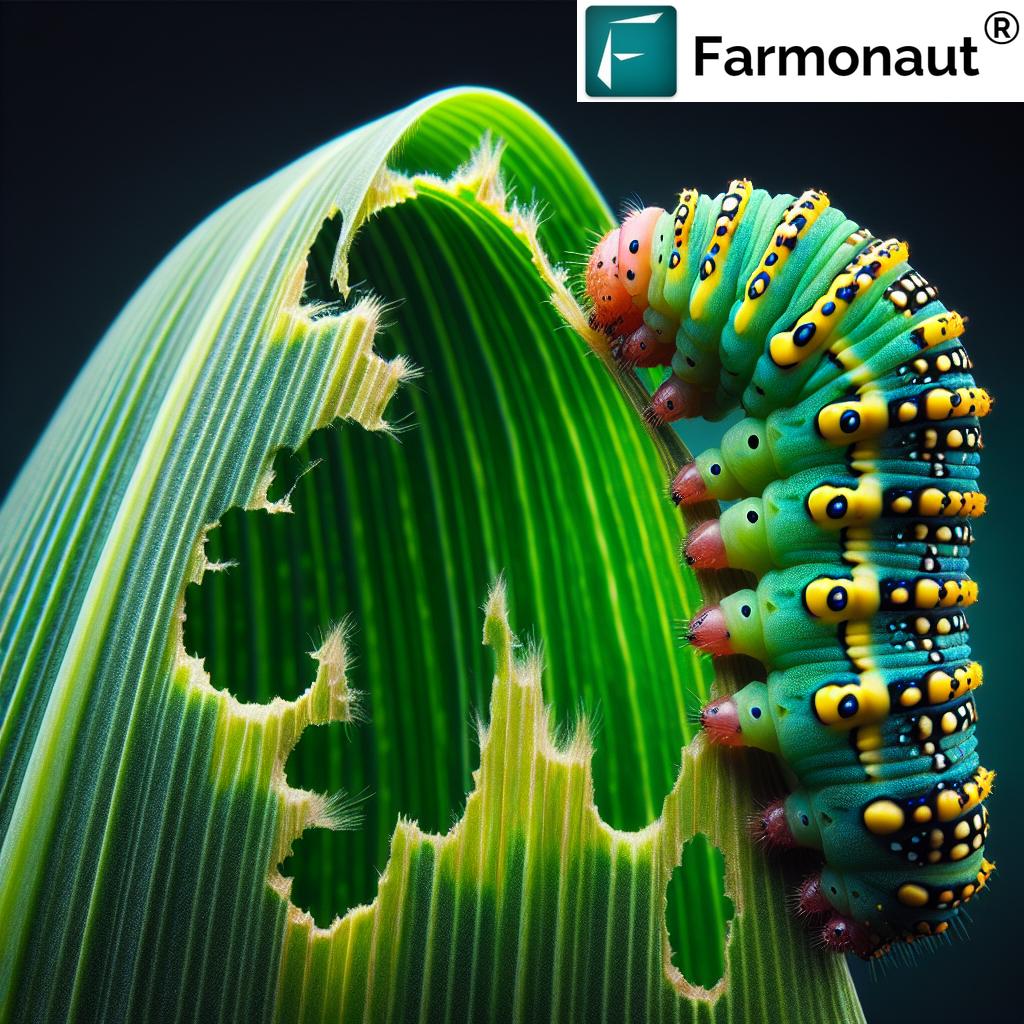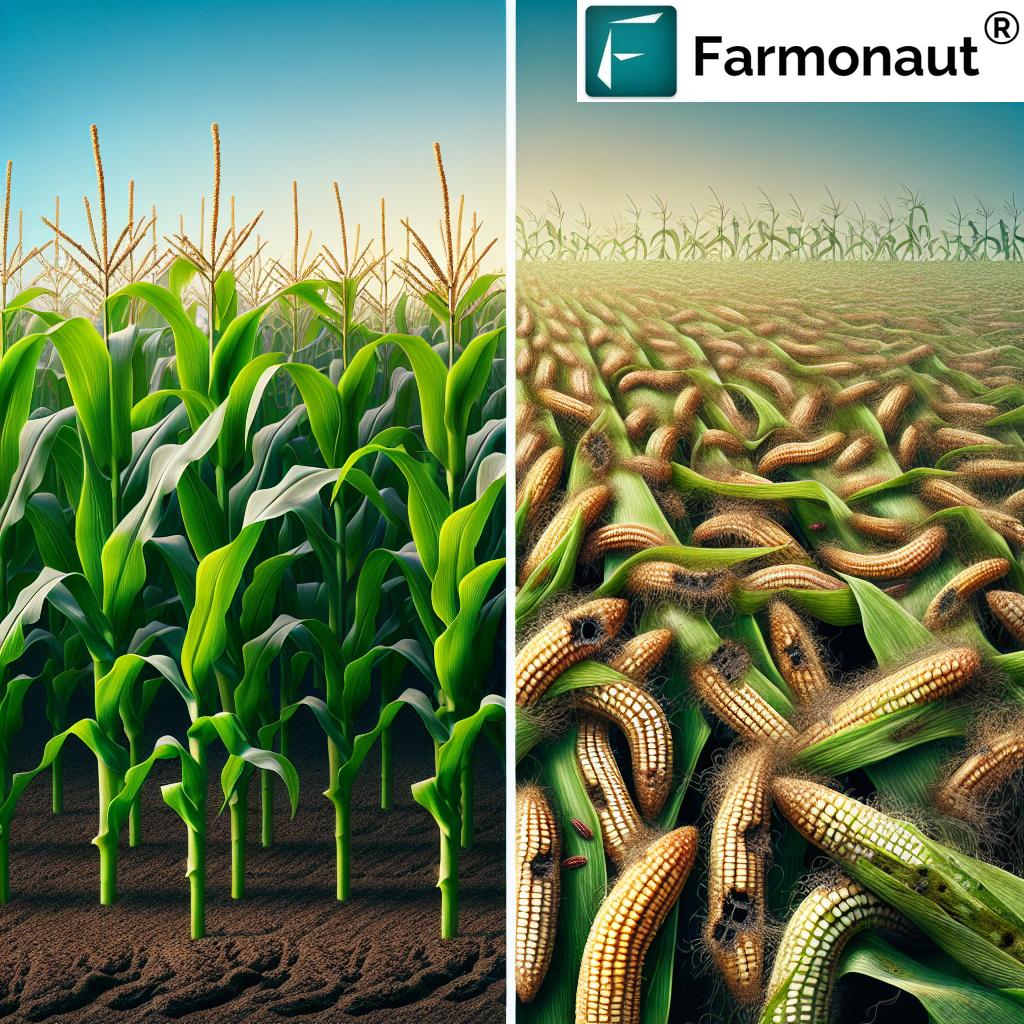Organic vs. Chemical: Effective Fall Armyworm Control Strategies for Maize, Cotton, and Vegetable Crops

In the ever-evolving world of agriculture, pest control remains a critical challenge for farmers worldwide. Among the most devastating pests in recent years, the fall armyworm (Spodoptera frugiperda) has emerged as a significant threat to various crops, including maize, cotton, and numerous vegetable species. As agricultural technology experts at Farmonaut, we understand the importance of effective pest management strategies that balance crop protection with environmental sustainability.
In this comprehensive guide, we’ll explore both organic and chemical control methods for combating the fall armyworm, providing farmers with the knowledge they need to make informed decisions about protecting their crops. We’ll delve into the biology of this persistent pest, its impact on various host plants, and the most effective strategies for minimizing crop damage while preserving ecological balance.
Understanding the Fall Armyworm: A Formidable Agricultural Pest
The fall armyworm, scientifically known as Spodoptera frugiperda, is a species of lepidoptera that has become a major concern for farmers across the globe. This voracious pest is known for its ability to cause significant damage to a wide range of crops, particularly in warm and humid climates.
Biology and Life Cycle
- Egg Stage: Female moths lay eggs in masses of 100-200 on the leaves of host plants.
- Larval Stage: Upon hatching, larvae begin feeding on the host plant, causing extensive damage to leaves and stems.
- Pupal Stage: Mature larvae pupate in the soil, emerging as adult moths after 7-10 days.
- Adult Stage: Adult moths can fly long distances, contributing to the rapid spread of this pest.
Host Plants and Crop Damage
The fall armyworm is known to attack a wide variety of crops, including:
- Maize (Corn)
- Rice
- Cotton
- Peanuts
- Soy
- Alfalfa
- Sorghum
- Sugarcane
- Bermuda grass
- Vegetable crops such as tomatoes, peppers, potatoes, and eggplant
- Tobacco
The damage caused by fall armyworm larvae can be devastating, often resulting in significant yield losses if left unchecked. Larvae feed voraciously on leaves, stems, and reproductive parts of plants, leading to stunted growth, defoliation, and in severe cases, complete crop failure.
Organic Control Strategies for Fall Armyworm Management
At Farmonaut, we recognize the growing importance of organic farming practices and their role in sustainable agriculture. Here, we’ll explore various organic methods for controlling fall armyworm populations without resorting to synthetic chemicals.
1. Biological Control
Biological control involves the use of natural enemies to manage pest populations. For fall armyworm control, several beneficial organisms can be employed:
- Parasitoid Wasps: Species like Trichogramma and Telenomus remus can effectively parasitize fall armyworm eggs.
- Predatory Insects: Ladybugs, lacewings, and predatory bugs can help control larvae populations.
- Entomopathogenic Nematodes: These microscopic worms can infect and kill fall armyworm larvae in the soil.
2. Microbial Insecticides
Certain microorganisms can be used as effective biopesticides against fall armyworm:
- Bacillus thuringiensis (Bt): This naturally occurring soil bacterium produces proteins toxic to fall armyworm larvae.
- Beauveria bassiana: This fungus can infect and kill fall armyworm larvae and adults.
- Nucleopolyhedrovirus (NPV): This virus specifically targets fall armyworm larvae, causing fatal infections.
3. Plant-Based Repellents and Insecticides
Many plants contain compounds that can repel or control fall armyworm:
- Neem Oil: Extracted from the neem tree, this natural insecticide disrupts the feeding and growth of fall armyworm larvae.
- Pyrethrum: Derived from chrysanthemum flowers, pyrethrum-based sprays can effectively control fall armyworm populations.
- Garlic and Chili Pepper Sprays: These homemade solutions can repel fall armyworm moths and deter egg-laying.
4. Cultural Control Methods
Implementing certain farming practices can help reduce fall armyworm infestations:
- Crop Rotation: Rotating crops can disrupt the life cycle of fall armyworm and reduce pest pressure.
- Intercropping: Planting companion crops that repel fall armyworm or attract natural enemies can help manage pest populations.
- Early Planting: Planting crops early in the season can help plants establish before peak fall armyworm activity.
- Proper Field Sanitation: Removing crop residues and weeds can eliminate potential overwintering sites for fall armyworm.
Chemical Control Strategies for Fall Armyworm Management
While organic methods are increasingly popular, chemical control remains an important tool in conventional farming for managing fall armyworm infestations. However, it’s crucial to use these methods judiciously to minimize environmental impact and prevent the development of pesticide resistance.
1. Synthetic Insecticides
Various classes of insecticides can be effective against fall armyworm:
- Pyrethroids: Fast-acting insecticides that target the nervous system of insects.
- Organophosphates: Broad-spectrum insecticides that can provide effective control of fall armyworm larvae.
- Carbamates: Another class of broad-spectrum insecticides effective against various insect pests, including fall armyworm.
- Spinosyns: Derived from soil bacteria, these insecticides are effective against lepidopteran pests like fall armyworm.
2. Insect Growth Regulators (IGRs)
IGRs interfere with the growth and development of fall armyworm larvae:
- Chitin Synthesis Inhibitors: These compounds prevent larvae from molting properly, leading to death.
- Juvenile Hormone Analogs: These chemicals disrupt the hormonal balance of larvae, preventing them from reaching adulthood.
3. Pheromone-Based Control
While not directly lethal, pheromone-based methods can be useful in managing fall armyworm populations:
- Mating Disruption: Synthetic pheromones can be used to confuse male moths, reducing successful mating.
- Mass Trapping: Pheromone-baited traps can be used to capture large numbers of adult moths, reducing egg-laying in crops.
4. Seed Treatments
Treating seeds with systemic insecticides can provide early-season protection against fall armyworm:
- Neonicotinoids: These systemic insecticides can protect young plants from early fall armyworm infestations.
- Diamide Insecticides: Another class of systemic insecticides that can be used as seed treatments for fall armyworm control.
Integrated Pest Management: Combining Organic and Chemical Approaches
At Farmonaut, we advocate for an Integrated Pest Management (IPM) approach that combines the best of both organic and chemical control methods. This strategy aims to minimize pesticide use while maintaining effective pest control and crop protection.
Key Components of IPM for Fall Armyworm Control:
- Monitoring and Early Detection: Regular field scouting and the use of pheromone traps to detect fall armyworm presence early.
- Economic Threshold-Based Decision Making: Applying control measures only when pest populations reach levels that justify the cost of treatment.
- Prioritizing Non-Chemical Methods: Utilizing biological control, cultural practices, and other organic methods as the first line of defense.
- Judicious Use of Chemical Controls: Employing chemical insecticides only when necessary and rotating between different modes of action to prevent resistance development.
- Habitat Management: Encouraging natural enemy populations by maintaining diverse landscapes around crop fields.

Farmonaut’s Role in Fall Armyworm Management
At Farmonaut, we’re committed to helping farmers implement effective fall armyworm control strategies through our advanced satellite-based farm management solutions. Our technology plays a crucial role in early detection, damage assessment, and precision application of control measures.
Fall Armyworm Detection and Management: Traditional Methods vs. Farmonaut Satellite System
| Aspect | Traditional Methods | Farmonaut Satellite System |
|---|---|---|
| Early Detection | Manual field scouting, time-consuming and labor-intensive | Satellite imagery analysis for early signs of infestation, covering large areas quickly |
| Damage Assessment | Visual estimation, prone to human error | Accurate quantification of affected areas using multispectral imagery |
| Precision Application | Broad application of control measures | Targeted treatment based on precise infestation mapping |
| Cost-Effectiveness | High labor costs for manual monitoring | Reduced monitoring costs and optimized resource allocation |
| Environmental Impact | Potential overuse of pesticides due to lack of precise information | Minimized pesticide use through targeted application, supporting sustainable farming practices |
Our satellite-based crop health monitoring system allows farmers to:
- Detect early signs of fall armyworm infestation through analysis of vegetation health indices.
- Assess the extent of crop damage caused by fall armyworm across large areas.
- Implement targeted control measures, reducing the need for broad-spectrum pesticide applications.
- Monitor the effectiveness of control strategies in real-time.
- Make data-driven decisions about when and where to apply control measures.
By leveraging Farmonaut’s technology, farmers can significantly improve their fall armyworm management strategies, leading to better crop protection, reduced pesticide use, and increased yields.
Best Practices for Fall Armyworm Control in Major Crops
While the general principles of fall armyworm control apply across various crops, certain strategies may be more effective for specific host plants. Here, we’ll explore best practices for managing fall armyworm in some of its primary host crops.
Maize (Corn)
Maize is one of the most susceptible crops to fall armyworm damage. Here are some specific strategies for protecting maize crops:
- Early Planting: Plant maize early in the season to allow crops to establish before peak fall armyworm activity.
- Push-Pull Technology: Intercrop maize with plants like Desmodium, which repels fall armyworm, and surround fields with trap crops like Napier grass.
- Bt Maize: Where permitted, consider planting genetically modified Bt maize varieties resistant to fall armyworm.
- Foliar Sprays: Apply biopesticides or chemical insecticides to the whorl of young plants where larvae often feed.
Cotton
Fall armyworm can cause significant damage to cotton crops, particularly during the early growth stages. Consider these strategies:
- Monitoring: Regularly inspect cotton plants for egg masses and young larvae, focusing on new growth.
- Beneficial Insects: Encourage natural predators like lady beetles and lacewings, which feed on fall armyworm eggs and small larvae.
- Targeted Spraying: If chemical control is necessary, target applications to areas of the field where infestations are highest.
- Crop Rotation: Rotate cotton with non-host crops to disrupt the fall armyworm life cycle.
Rice
While not as commonly associated with fall armyworm as maize, rice can also be vulnerable to this pest. Consider these approaches:
- Water Management: Maintain proper water levels in rice paddies, as fall armyworm larvae are less likely to survive in flooded conditions.
- Pheromone Traps: Use pheromone traps to monitor adult moth populations and time control measures accordingly.
- Biological Control: Encourage populations of natural enemies like parasitoid wasps that are effective in rice ecosystems.
- Resistant Varieties: Where available, plant rice varieties with some level of resistance to fall armyworm.
Vegetable Crops (Tomatoes, Peppers, Eggplant)
Fall armyworm can cause significant damage to various vegetable crops. Here are some strategies for protection:
- Physical Barriers: Use row covers or netting to prevent moths from laying eggs on young plants.
- Companion Planting: Interplant vegetables with herbs like basil or marigolds, which can repel fall armyworm moths.
- Hand Picking: In small-scale operations, manually remove and destroy egg masses and larvae.
- Biopesticides: Apply Bt or other microbial insecticides regularly, especially during periods of high pest pressure.
The Future of Fall Armyworm Control: Emerging Technologies and Approaches
As agricultural technology continues to evolve, new methods for managing fall armyworm are emerging. At Farmonaut, we’re at the forefront of these developments, integrating cutting-edge solutions into our farm management platform.
1. Artificial Intelligence and Machine Learning
AI and machine learning algorithms are being developed to:
- Analyze satellite imagery and drone footage to detect early signs of fall armyworm infestation.
- Predict fall armyworm outbreaks based on historical data, weather patterns, and crop conditions.
- Optimize the timing and application of control measures for maximum effectiveness.
2. Gene Editing and RNAi Technology
Advanced biotechnology techniques are being explored for fall armyworm control:
- CRISPR Gene Editing: Developing crop varieties with enhanced resistance to fall armyworm.
- RNA Interference (RNAi): Creating biopesticides that target specific genes in fall armyworm, disrupting their growth and development.
3. Precision Agriculture and Variable Rate Technology
Integrating fall armyworm control into precision agriculture systems:
- Using GPS-guided equipment to apply control measures only where needed, based on infestation maps generated from satellite data.
- Implementing variable rate technology to adjust application rates of biopesticides or chemical insecticides based on the severity of infestation in different parts of a field.
4. Pheromone-based Mating Disruption on a Large Scale
Developing more effective and environmentally friendly pheromone-based control methods:
- Creating long-lasting pheromone dispensers for season-long mating disruption.
- Exploring the use of drones for aerial application of pheromones over large areas.
5. Mobile Apps and Decision Support Tools
Developing user-friendly mobile applications to assist farmers in fall armyworm management:
- Real-time pest identification using smartphone cameras and AI algorithms.
- Providing customized treatment recommendations based on crop type, infestation level, and local conditions.
- Facilitating community-based pest monitoring and early warning systems.
Conclusion: A Holistic Approach to Fall Armyworm Management
Effectively controlling fall armyworm requires a comprehensive, integrated approach that combines the best of organic and chemical control methods. By leveraging advanced technologies like Farmonaut’s satellite-based crop monitoring system, farmers can detect infestations early, apply targeted control measures, and minimize crop losses while reducing environmental impact.
As we continue to face the challenges posed by pests like the fall armyworm, it’s crucial to stay informed about the latest research and management strategies. By combining traditional farming wisdom with cutting-edge technology, we can develop sustainable, effective solutions for protecting our crops and ensuring food security for future generations.
At Farmonaut, we’re committed to supporting farmers in their fight against fall armyworm and other agricultural pests. Our advanced farm management solutions provide the tools and insights needed to implement successful IPM strategies, optimize resource use, and maximize crop yields.
To learn more about how Farmonaut can help you manage fall armyworm and other crop challenges, visit our website or download our mobile app:
For developers interested in integrating our satellite and weather data into their own systems, check out our API documentation.
Frequently Asked Questions (FAQ)
-
Q: What is the fall armyworm, and why is it such a significant pest?
A: The fall armyworm (Spodoptera frugiperda) is a species of moth that causes extensive damage to crops in its larval stage. It’s considered a significant pest due to its wide host range, rapid reproduction, and ability to quickly develop resistance to pesticides. -
Q: Which crops are most susceptible to fall armyworm damage?
A: Fall armyworm primarily targets maize (corn), but it also attacks other crops such as rice, cotton, sorghum, sugarcane, and various vegetables including tomatoes, peppers, and eggplant. -
Q: How can I identify fall armyworm infestation in my crops?
A: Look for signs such as irregular holes in leaves, sawdust-like frass in the whorl of plants, and visible larvae feeding on leaves and stems. In severe cases, you may notice significant defoliation and damage to the reproductive parts of plants. -
Q: What are some effective organic control methods for fall armyworm?
A: Organic control methods include the use of biological control agents like parasitoid wasps, application of biopesticides such as Bacillus thuringiensis (Bt), and cultural practices like crop rotation and intercropping. -
Q: Are chemical insecticides necessary for controlling fall armyworm?
A: While organic methods are preferable, chemical insecticides may be necessary in cases of severe infestation. However, they should be used judiciously as part of an integrated pest management (IPM) approach to prevent resistance development and minimize environmental impact. -
Q: How can Farmonaut’s technology help in managing fall armyworm infestations?
A: Farmonaut’s satellite-based crop monitoring system can detect early signs of infestation, assess damage extent, and help farmers implement targeted control measures. This technology enables more efficient and cost-effective pest management strategies. -
Q: Is it possible to completely eradicate fall armyworm from my farm?
A: Complete eradication is challenging due to the pest’s mobility and rapid reproduction. The goal is to manage populations below economic thresholds through integrated pest management strategies. -
Q: How often should I monitor my crops for fall armyworm?
A: Regular monitoring is crucial, especially during vulnerable growth stages. We recommend weekly scouting, with more frequent checks during peak infestation periods or in high-risk areas. -
Q: Can fall armyworm develop resistance to control methods?
A: Yes, fall armyworm can develop resistance, particularly to chemical insecticides. This is why it’s important to rotate control methods and integrate various strategies rather than relying on a single approach. -
Q: Are there any new technologies being developed for fall armyworm control?
A: Yes, emerging technologies include AI-driven pest detection systems, gene editing for crop resistance, and advanced pheromone-based control methods. Farmonaut continues to integrate these innovations into our farm management solutions.












